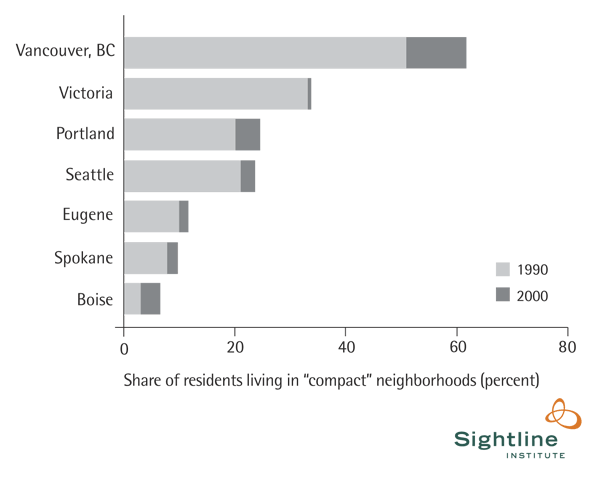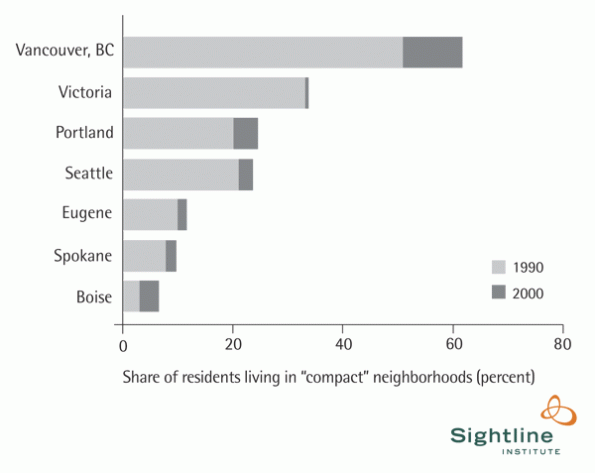Low-density sprawl—where houses, jobs, and stores are spread out, and virtually every trip requires a car—remains the norm in Cascadia’s major metropolitan areas. But compact neighborhoods are gradually gaining ground: since 1990, the share of residents living in walkable or transit-oriented neighborhoods has increased in each of the seven largest major Northwest metropolitan areas.
Poorly planned, low-density sprawl contributes to a panoply of ills. It confines residents in their cars for virtually every trip; increases transportation and infrastructure costs; overruns farmland; frays forests; harms streams and wildlife; and commits the region to exorbitant expenditures on roads, vehicles, and highway fuels. It even undermines health by limiting exercise and increasing car crashes.
Today, nearly two-thirds of the people living in Cascadia’s major metropolitan areas reside in a neighborhood where a car is a virtual necessity. Yet Sightline’s analyses of census data show that Northwest cities are making slow progress in channeling new growth into compact, transit- and pedestrian-oriented neighborhoods.The antidote to sprawl is compact development. International research suggests that as residential densities increase, driving decreases, and transit and walking start to become viable alternatives to the car. Residents of compact neighborhoods typically consume less gasoline, and create fewer climate-warming emissions for everyday transportation needs, than do residents of more sprawling locales. Compact cities and town also cover less of the landscape with pavement, while sparing farmland, forests, and lowland habitats at the urban fringe from sprawling development.
Among Northwest cities, Vancouver, BC, leads the way in corralling sprawl: 64 percent of the metropolitan area’s urban and suburban residents live in areas with at least 12 residents per acre. In fact, Vancouver has the most compact urban structure of any of the 19 cities Sightline has analyzed to date. (Click to read Sightline’s study of sprawl in cities across the US). Compared with its neighbors to the south, greater Vancouver excels both at protecting farmland from low-density sprawl, and at channeling new residents into compact neighborhoods.
A combination of factors — ranging from a topography constrained by water and mountains, to British Columbia’s province-wide farmland protection policies, to political leadership committed to preserving a “livable region,” to a less extensive highway system than is found in many parts of North America — has helped channel much of Vancouver’s new growth into already-developed areas.
But data from the 2006 Canadian Census revealed a surprise: Greater Vancouver’s leadership in compact growth slipped during the last census period. Compared with the previous decade, the share of new urban and suburban growth that went into compact communities declined, while the amount of land developed to accommodate new residents increased. This slowdown in smart growth took place at a time when overall population growth slowed as well. Those two trends may be linked: slower-growing cities may be less likely to accommodate new residents in higher-density developments.
Despite the disappointing smart-growth news, the cities of Vancouver and North Vancouver did make notable progress in fostering walkable, pedestrian-friendly neighborhoods between 2001 and 2006. In Vancouver, neighborhoods with “pedestrian-oriented” densities (at least 40 residents per acre) grew by 27,000 residents. That was about four-fifths of all population growth that occurred within city limits. By 2006, more than one in four city residents, or nearly 160,000 Vancouverites, lived in neighborhoods with pedestrian-oriented densities.
(Click to read “Slowing Down,” Sightline’s report on recent smart growth trends in greater Vancouver.)
Keys to combating sprawl include strong protections for farmland and open space at the urban fringe; promoting infill development; and limiting sprawl-inducing road projects. Based on census figures, Portland’s growth management system has clearly worked to limit low-density sprawl on rural land surrounding the city; but so far, Washington’s nascent program has had less success.










